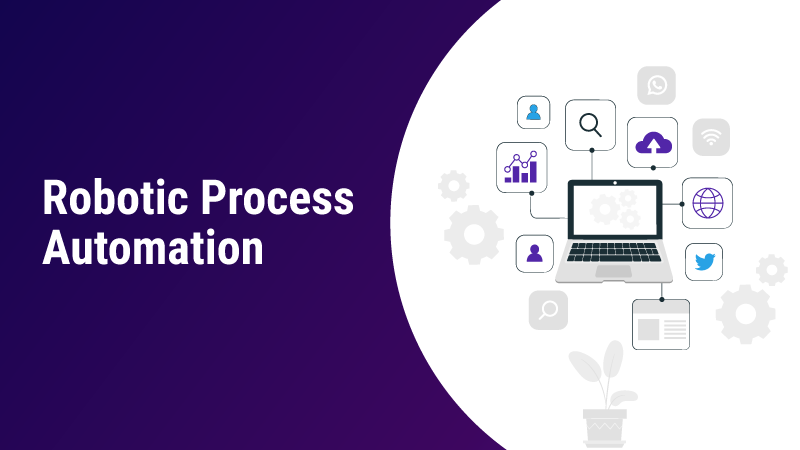Challenges in RPA Implementation and How to Overcome Them

Have you ever thought of a robot that could finish all the pile of work around you? This is exactly what ClaySys offers you through our RPA services. The current world technology has grown to the point where robots can mimic humans, performing many tasks that need to be done manually. Software bots are the best solution to this problem as there is a lot of tedious work across various industries, that uses a lot of human resources, time, and cost. By automating such tedious tasks, human workers can spend time on tasks that are actually in need of human intelligence and creativity. In this article, we are going to discuss the main challenges in Robotic Process Automation and the solutions to overcome those challenges.
What is Robotic Process Automation?
Robotics Process Automation (RPA) is the software technology that uses automation technologies to perform tasks at a lower cost, with higher efficiency, and on a larger scale than human workers. These software bots can mimic human activities and automate repetitive tasks that are said to be performed by humans only. RPA Bots, thus enable manual workers to focus more on tasks that need to be performed with intelligence, and manpower than the tedious jobs. Automation of tasks not only takes away the weight of such boring and time-consuming activities but also assists in speeding up the process with no or few manual workers. Keeping aside all these, the most interesting part is that the use of RPA bots is not confined to any particular industry as it can be applied across multiple industries for many benefits, uses, and accelerating growth of each sector in the company.
Challenges in RPA
For every coin, there are two sides. Likewise, Robotic Process Automation has its benefits as well as challenges. It is important to know the problems that a newly adopted technology may face in the long run. Here we are going to discuss some of the major challenges that a company may face while deploying RPA.
Availability of skilled resources
Deployment of Robotic Process Automation in any industry is a very special and critical task, and strong team leadership is needed to guide the team until the successful completion of the RPA deployment task. In the current RPA market, there is an inadequacy of skilled resources. Gathering resources at the beginning of a new project and replenishing when a major resource runs out is the biggest threat to the successful completion of any project. Moreover, good coordination and involvement of employees at every level of the organization during the automation process are very important. Coordination between each employee not only helps to complete the task more accurately but also enables the organization to generate a system that syncs with RPA. If the IT team is made a part of the process while building the infrastructure, it will reduce risk and ensure safety standards.
Over and unclear expectations
It is essential to have a plan before going through a new process or procedure and there should be clarity in the final result we are going to after implementing the process. This is the same concept used for RPA deployment. The unclear idea among the employees about the final output of the process can have a huge impact on the project. This is why it is important to give clarity about the entire process and its final outcome to every department involved in the project. This will reduce any kind of confusion on many topics, thus allowing the employees to work with clarity. Sometimes high expectations are relied on the RPA projects even before building the infrastructure. But the results may vary from the expectations once the project is developed and deployed.
Technical ambiguity
RPA installation is very easy and therefore it is considered to be one of the key features of RPA. Though the installation is easy, for the successful RPA deployment it is important for the technical staff to conduct in-depth research in order to answer and meet technical and functional queries. RPA maintenance is a critical factor and therefore requires a regular protocol to be followed for maintaining RPA, otherwise, it can lead to many problems.
Picking the wrong RPA
Choice matters! Choosing the right option is one of the commonly found issues an organization may face while implementing an RPA project. The implementation phase is when the organization realizes that they have chosen the wrong RPA tool for their business. They come to know that it is not appropriate for them only when they are unable to meet the requirements of the customer and when the investment outrun their expectation. Therefore, choosing the right tools for RPA implementation should be at the top of the list.
Disconnected dots
Consider what would be a suitable structure for an RPA Center for Excellence (CoE). As mentioned before, RPA implementation is a crucial task, and the absence of responsibility from the side of any employee can lead to poor performance. In order to best serve the certain objectives of your organization, it is essential that you assign tasks and specify roles, responsibilities, and abilities to the people involved in this automation process. This makes them responsible for their duties and everything will go as planned.
Infrastructure issues
Issues associated with the infrastructure are one of the main challenges faced while implementing RPA. Lack of appropriate infrastructure not only makes it difficult to bring everyone on board but also can create complications if there is no interconnected system in the organization that performs real-time updates on cloud infrastructure or on-premises. Without proper infrastructure and a centralized infrastructure team, it is difficult to speed up the process of RPA implementation.
Wrap Up
Robotic Process Automation eliminates obstacles that may arise from the routine running of the business and helps in improving the business processes. Therefore, we can conclude by saying that knowledge about the challenges faced by different projects provides a checklist to prepare for not falling into one of the categories mentioned above.
Get Started with our RPA ServicesRead more about RPA
Blogs by Category
AppForms Artificial Intelligence Blockchain Call Centers Chatbots Cloud Computing Data Management Design Digital Marketing Digital Transformation Enterprise Applications FinTech Insights LowCode Development Microsoft Mobile Apps News Office 365 Robotic Process Automation Security SharePoint Software Development Web ApplicationWhat is Robotic Process Automation? RPA Explained

2024-05-23 16:56:57